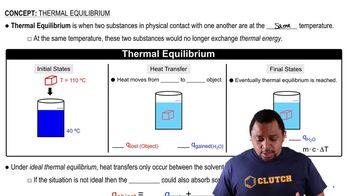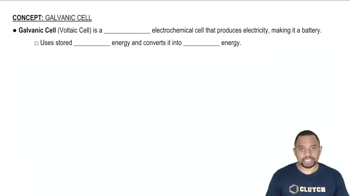(b) Can the “fuel” of a fuel cell be a solid?
Ch.20 - Electrochemistry
Chapter 20, Problem 84
(b) When the Statue of Liberty was refurbished, Teflon spacers were placed between the iron skeleton and the copper metal on the surface of the statue. What role do these spacers play?
 Verified step by step guidance
Verified step by step guidance1
Step 1: Understand the materials involved. The Statue of Liberty has an iron skeleton and a copper surface. Iron and copper are two different metals with distinct properties.
Step 2: Consider the concept of galvanic corrosion. When two different metals are in contact in the presence of an electrolyte (like rainwater), a galvanic cell can form, leading to corrosion of the more reactive metal.
Step 3: Identify the role of Teflon spacers. Teflon is a non-conductive material, which means it can act as an insulator between the two metals.
Step 4: Explain how Teflon spacers prevent corrosion. By placing Teflon spacers between the iron and copper, the direct contact is eliminated, preventing the formation of a galvanic cell and thus reducing the risk of corrosion.
Step 5: Conclude the importance of the spacers. The Teflon spacers help preserve the structural integrity of the statue by preventing the iron from corroding, which would weaken the structure over time.
Key Concepts
Here are the essential concepts you must grasp in order to answer the question correctly.
Corrosion Prevention
Corrosion is the deterioration of materials, often metals, due to chemical reactions with their environment. In the case of the Statue of Liberty, the Teflon spacers help prevent corrosion by acting as a barrier between the iron skeleton and the copper surface, reducing direct contact and the potential for galvanic corrosion, which occurs when two different metals are in contact in the presence of an electrolyte.
Recommended video:
Guided course

Molecular Orbital Theory
Thermal Expansion
Materials expand and contract with temperature changes, a phenomenon known as thermal expansion. The Teflon spacers accommodate the differing rates of expansion between the iron and copper, preventing stress and potential structural damage. This is crucial for maintaining the integrity of the statue as it is exposed to varying weather conditions.
Recommended video:
Guided course

Thermal Equilibrium
Electrical Insulation
Teflon is an excellent electrical insulator, meaning it does not conduct electricity. By placing Teflon spacers between the iron and copper, the risk of electrical conduction is minimized, which is important in preventing galvanic corrosion. This insulation helps to maintain the longevity of both metals in the statue's structure.
Recommended video:
Guided course

The Galvanic Cell
Related Practice
Textbook Question
1
views
Textbook Question
Iron corrodes to produce rust, Fe2O3, but other corrosion products that can form are Fe(O)(OH), iron oxyhydroxide, and magnetite, Fe3O4. (a) What is the oxidation number of Fe in iron oxyhydroxide, assuming oxygen's oxidation number is -2? (b) The oxidation number for Fe in magnetite was controversial for a long time. If we assume that oxygen’s oxidation number is - 2, and Fe has a unique oxidation number, what is the oxidation number for Fe in magnetite? (O)(OH), iron oxyhydroxide, and magnetite, Fe3O4. (c) It turns out that there are two different kinds of Fe in magnetite that have different oxidation numbers. Suggest what these oxidation numbers are and what their relative stoichiometry must be, assuming oxygen’s oxidation number is -2.
